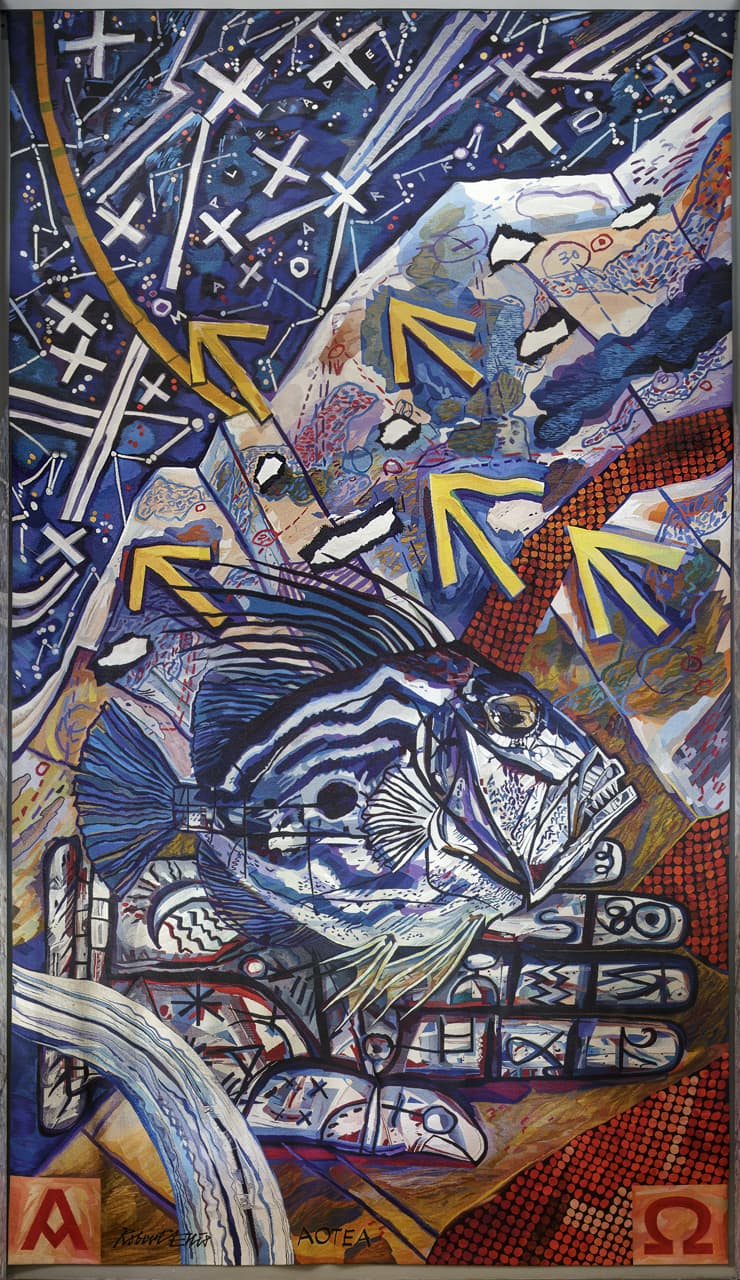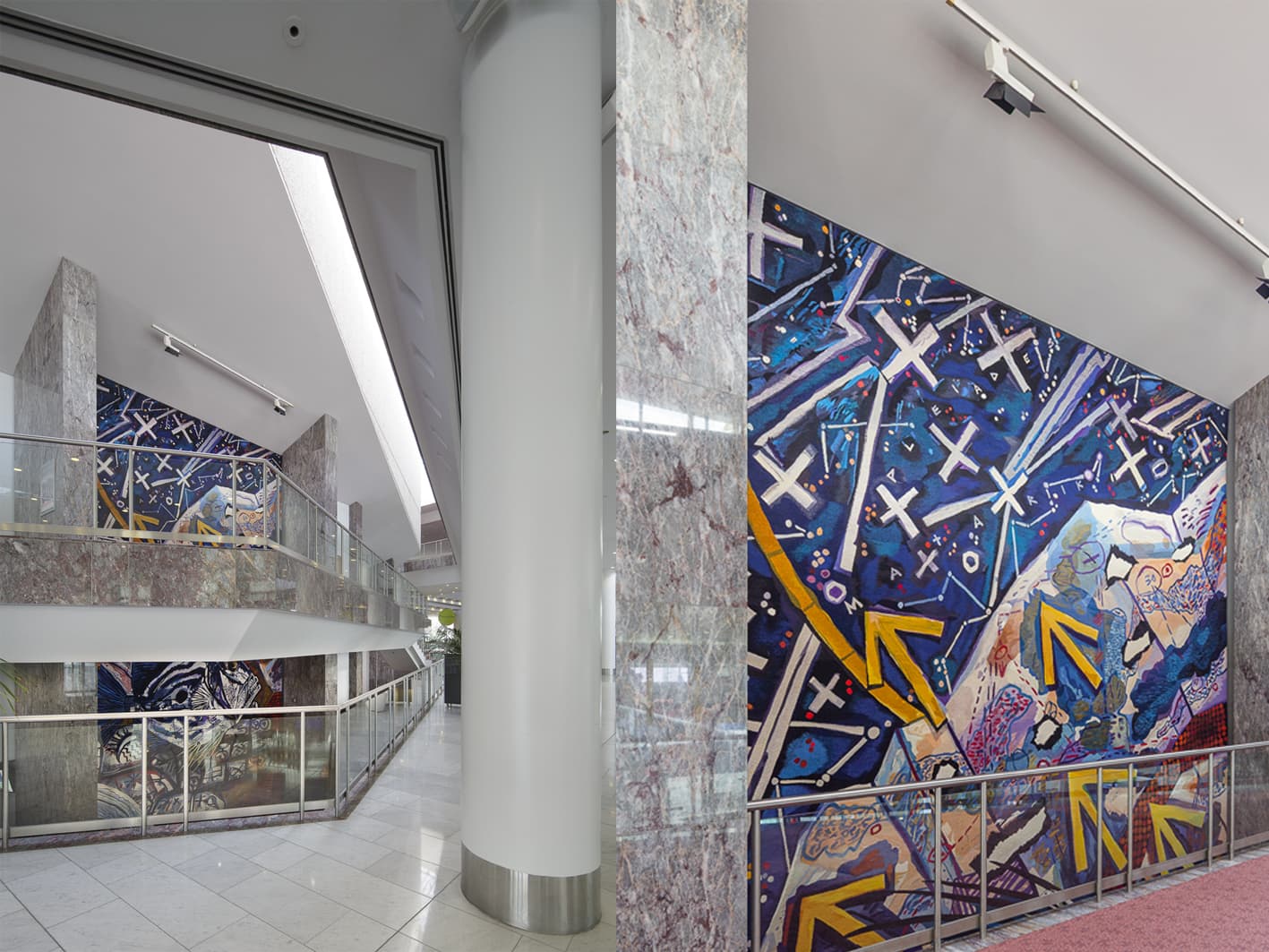


Taking six ATW weavers almost 2 years to complete, the Aotea Tapestry, designed by Robert Ellis is a significant contemporary tapestry and one of the principle artworks in the Aotea Centre’s collection.
Ellis is a prominent British-born New Zealand painter who is concerned with social, cultural and environmental themes.
Speaking of the tapestry, Ellis noted: “It was not my intention to be too specific, as many people will prefer to interpret it in their own way. There are many different levels of meaning, depending on the viewer’s outlook.”
Robert Ellis’ work is held in many major institutions. He is represented by Milford Galleries in Dunedin.
The ATW produced the monumental Great Hall Tapestry, spanning 9.18 x 19.9m, and designed by prominent Australian artist Arthur Boyd, for Parliament House in Canberra in 1988.
Boyd (1920-1999) is considered to be one of Australia's most distinguished 20th-century artists. He came from the Boyd dynasty of painters, sculptors, ceramicists and architects, and was part of the Angry Penguins school in the 1940s and later the Antipodeans, which included John Perceval and Charles Blackman. Boyd represented Australia at the Venice Biennale in 1958 and again in 2000. In 1979 he was awarded an Order of Australia, augmented by a Companion of the Order of Australia in 1992.
The design of Parliament House in Canberra was won by architect Romaldo Giurgola in 1979, and created the opportunity for the commission of a major public artwork. As an eminent living artist Arthur Boyd was offered the chance to produce an artwork that would cover almost the entire south wall of the Reception Hall. Extensive discussions ensued about the best medium to suit this scale, and tapestry was decided on as the ideal choice.
The tapestry design represents a forest of towering eucalyptus trees from the grounds of Boyd's rural retreat and studio at Bundanon. The tree-scape is quintessentially Australian, a homage to the majesty of the bush. Strong vertical rhythms structure the work, and the life-like proportions of the trees recreate the enveloping feel of a forest setting, fulfilling the architect's brief that the entire wall would almost appear as a three-dimensional living landscape.
The massive scale of the work - an astonishing nine meters in height and almost twenty meters in width - makes it the second largest tapestry in the world. It was woven in vertical sections by 12 weavers over a two-year period, and remains the most ambitious tapestry the Workshop has ever produced.
Arthur Boyd’s legacy is maintained through the Bundanon Trust collection and many major collections in Australia and overseas.
Woven in 1984, Roger Kemp’s Evolving Forms was designed to hang in the Great Hall of the National Gallery of Victoria (NGV).
Kemp was one of the earliest artists to work with the ATW. His visual language of symbolic forms made for a dynamic translation into tapestry. Kemp’s tapestry Images was commissioned in 1978 and acquired by the National Gallery of Victoria (NGV) in the same year.
Evolving forms became the first in a suite of three tapestries designed by Kemp for, and conceived as a response to, the Great Hall and its extraordinary faceted glass ceiling designed by Leonard French. Both artists' works harmonise: the broad steel trusses of the vaulted ceiling, with its bright glass, find an echo in the charcoal bands that delineate the abstract forms and jewel-like colours of ruby-red, turquoise, lilac and amethyst-pink in Kemp's tapestries.
Roger Kemp was a major contributor to the development of abstract painting in Australia. His work is housed in major collections in Australia and overseas.
ATW weaver and artist Marie Cook designed Pink Heath specifically for the Sofitel Hotel in 1979.
The choice to weave the tapestry on it's side limited the number of weavers that could work on the piece. Five weavers took nearly one year to complete the tapestry and it was the Workshop's most time-consuming project to date.
Pink Heath was created alongside Cook's Wattle. The Cutting Off Ceremony for Pink Heath in 1980 was a europhic occasion, with all the weavers dressed in pink to match the tapestry.